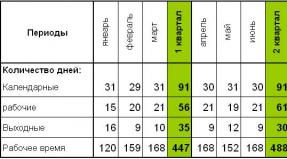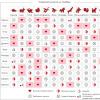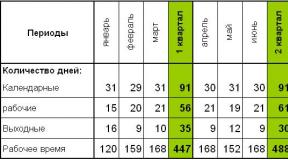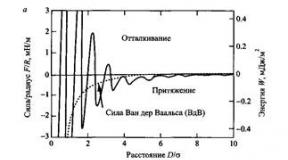Simple self-oscillating voltage converters using transistors. Do-it-yourself frequency generator - amateur converter circuit Simple converter using domestic transistors
For the circuit "VOLTAGE CONVERTER PN-32"
Power supply VOLTAGE CONVERTER PN-32(S) RINTELSai Oleg, (RA3XBJ). The converter is designed to power equipment with a rated voltage of 12 V (CB radio stations, radios, televisions, etc.) from the on-board network of cars with a voltage of 24 V. Maximum load current converter up to 3A short-term and 2-2.5 A long-term (determined by the area of the output transistor radiator). Efficiency 75-90% depending on load current. Scheme converter does not contain scarce parts. The inductor is wound on a ferrite ring with a diameter of 32 mm and has 50 turns of PETV-0.63 wire. Dimensions converter 65x90x40 mm. Questions about the design can be asked to the author [email protected]...
For the "VOLTAGE CONVERTER" circuit
Power supply VOLTAGE CONVERTER S.Sych225876, Brest region, Kobrin district, Orekhovsky village, Lenin st., 17 - 1. I propose a simple and reliable scheme converter voltage for controlling varicaps in various designs, which produces 20 V when supplied from 9 V. Option selected converter with a voltage multiplier, since it is considered the most economical. In addition, it does not interfere with radio reception. A pulse generator close to rectangular is assembled on transistors VT1 and VT2. A voltage multiplier is assembled using diodes VD1...VD4 and capacitors C2...C5. Resistor R5 and zener diodes VD5, VD6 form a parametric voltage stabilizer. Capacitor C6 at the output is a high-pass filter. Consumption current converter depends on the supply voltage and the number of varicaps, as well as their type. It is advisable to enclose the device in a screen to reduce interference from the generator. A correctly assembled device works immediately and is not critical to the ratings of the parts....
For the circuit "Voltage converter for battery equipment"
Power supply Voltage converter for battery equipment. PN-31 (C) RINTELSAY Oleg, (RA3XBJ). The converter is designed to power electronic equipment with a rated supply voltage of 5 ... 9 volts from a 2 ... 4.5 volt battery, including emergency power supplies. Maximum power converter up to 1.5 - 2 W, no-load current with an output voltage of 9 volts and powered from a 2.2 V source is approximately 30-35 mA. Efficiency converter at 9V output and powered from a 2.2V source, approximately 75 percent(s). Output voltage converter is set by the zener diode used. The inductor is wound on a ferrite ring with a diameter of 10 mm and has 40 turns of PEVTL wire - 0.35. The size of the printed circuit board is 40x23 mm. Questions about the design can be asked to the author [email protected]...
For the "PARAMETRIC CONVERTER" circuit
Amateur radio equipment units PARAMETRIC CONVERTER Modern communication HF receivers often use an intermediate frequency amounting to tens of megahertz (the so-called “up conversion”). The advantage of such receivers is their very high selectivity over the mirror channel and the likelihood of a simple circuit implementation of smooth tuning over the entire range of received short waves. In this case, it is often possible to simplify the input circuits by making them in the form of a low-pass filter with a cutoff frequency of 30 MHz. To obtain perhaps greater signal amplification at KB, it is advisable to choose a higher role for the intermediate frequency, but at the same time, the intermediate frequency should be convenient for subsequent amplification and conversion. In amateur conditions, the most convenient frequency is 144 MHz. It lies significantly above the upper limit of the HF range, and VHF receivers can be used for further signal processing. 1. It is made according to a balanced circuit using two varicaps VI and V2. A pump voltage equal in amplitude and opposite in phase to the varicaps is supplied from the secondary winding of transformer T1, which has a grounded tap from the midpoint. The required initial mixing voltage on the varicaps is created using a divider on resistors R1, R4, R5, R6. The trimmer resistor R5 is used to balance the converter. The input signal is supplied through the coupling coil L2 to the circuit L3C7, tuned to a frequency of 7 MHz. This circuit is connected to the anodes of the varicaps through a separating capacitor C5 and inductor L1. The output circuit L4C8, tuned to an intermediate frequency of 144 MHz, is connected to the anodes of the diodes through a small capacitor Sb. Cha...
For the circuit "POWER VOLTAGE CONVERTER ON THYRISTORS"
Power supply POWERFUL VOLTAGE CONVERTER ON THYRISTORS A. BERNSTEIN, M. BOSYKH Vorkuta The described device is designed to convert a direct voltage of 12 V into an alternating voltage from 200 to 500 V and can deliver power up to 500 watts to the load. Scheme converter presented in the figure. The frequency of the output alternating voltage is determined by the pulse frequency of the self-oscillator, made on transistors T1 and T2. These pulses control thyristor switches D1 and D2 through transformer Tr1, which alternately connect one or the other half of the primary winding of transformer Tr2 to a constant voltage source. The load is connected to terminals 4-5 of transformer Tr2. Quality of work converter voltage largely depends on the correct selection of the capacitance of capacitor C4, since the voltage on this capacitor alternately closes thyristors D1 and D2. The capacitor is selected correctly if, when the supply voltage fluctuates within +-10%, clear alternating closing of the keys is ensured. Catalog printed circuit board gold miner The use of isolation capacitors C2 and C3 increases the stability of the converter. Resistor R3 protects the power source from short circuits when switching keys. The output voltage frequency of the device with the specified data is 200 Hz. If we foresee the possibility of changing the frequency of the self-oscillator (for example, instead of a self-oscillator, assemble a frequency-controlled multivibrator with a power amplifier), then the output can produce a voltage with a frequency of 50-400 Hz, which will allow it to be used for smooth control of the rotation speed of synchronous electric motors with a power of up to 500 W. By changing the number of turns of the secondary winding of transformer Tr2 accordingly, you can get the output...
For the circuit "BIPOLAR VOLTAGE FORMER"
Power Supply BIPOLAR VOLTAGE FORMER The circuit shown in the figure can be very useful when the TTL circuit has an analog circuit that consumes a low but symmetrical bipolar voltage (for example, an operational amplifier). Since current TTL systems usually only have a +5 V supply voltage, a symmetrical supply voltage must be obtained from this. In a transformerless converter, ingredient G1 serves as a square pulse generator; at the indicated values of R1 and C1, its frequency is approximately 100 kHz, and the signal has TTL levels. G2 and G3 "buffer" the two channels separately. Full-wave rectifiers are connected to the outputs of both buffers, the elements of which are connected in opposite polarities in relation to each other, so at the outputs converter There are symmetrical voltages t8.5 V with a permissible load of 10 mA. Considering the relatively high operating frequency of the converter, for C2 C5 it is necessary to use, if possible, tantalum capacitors Hobby Elek>tromka, N7/97. Translation by A. Belsky (RL-1/99)...
For the circuit "ECONOMICAL VOLTAGE CONVERTER"
Power supply ECONOMICAL VOLTAGE CONVERTER. GRIDNEVg. Barvenkovo, Kharkov region. The voltage converter that powers the electronic tuning varicaps of the Leningrad-002 transistor receiver has a rather long (about 1.5 s) time to establish the output voltage, therefore, when the HF and VHF bands are turned on, specific interference occurs caused by the frequency tuning of the receiver. As experiments have shown, the main reason for the delay in establishing the output voltage is the use of a compensation voltage stabilizer, which consumes a current of several milliamps, as well as the large capacitance of the filter capacitor. Since a decrease in the capacitor capacitance is unacceptable due to increased ripple, it was decided to replace the converter with a stabilizer with a device in which the output the voltage is maintained constant by negative feedback (NFC), which controls the operation of the autogenerator. The schematic diagram of the new voltage is shown in the figure. Block diagram of the 251 1HT microcircuit The regulated OOS circuit is formed by field-effect transistors VT3 (bias voltage regulator), VT4 (amplifier), VT5 (current generator). The device works as follows. At the moment the power is turned on, when there is no voltage at the output, transistors VT4. VT5 are de-energized. After starting the generator using VTI transistors. VT2 a constant voltage appears at the output and current flows through the circuit RЗVT5R4R5). As the output voltage increases, it increases until it reaches a certain limit depending on the resistance of resistor R3. Further increase in the output voltage converter accompanied by...
For the "ECONOMICAL POWER SUPPLY" circuit
Power supply ECONOMICAL POWER SUPPLY V. TSIKULSKY, Ternopil Reducing weight and dimensions and increasing the efficiency of power supplies is one of the urgent tasks in the design of modern electronic equipment. This problem is most easily solved by replacing the traditional rectifier (with a mains transformer and capacitive filter) with a high-frequency converter, followed by rectification of the high-frequency voltage. Such power supplies, due to the fact that voltage conversion occurs at a relatively high frequency (10...40 kHz), have transformers and the entire structure of significantly smaller dimensions and hence a higher power density, reaching up to 200...400 W/cubic meter. dm, which is several times more than that of traditional power supplies. The schematic diagram of such a power supply is shown in the figure. At the output of the block, a bipolar voltage of 2x27 V is obtained at a load current of up to 0.6 A. The amplitude of the output voltage ripple at the maximum load current does not exceed 30 mV. The mains voltage rectifier is assembled on diodes V1-V4. Description of microcircuit 0401 The rectified voltage converter is made on transistors V6, V7 and transformers T1 and T2, and the high-frequency voltage rectifier is made on diodes V8-V11. Operating voltage frequency 22 kHz. Capacitors C1 and C2 are necessary to protect the supply network from interference; arising during the operation of the converter. Resistors R1 and R2, together with capacitors C3C4, are the primary filter and at the same time a voltage divider for the converter. Chain V5. R3, C5, R5 serve to facilitate starting the converter generator. - Capacitors C6, C7 serve as a filter for rectified high-frequency voltage. The use of two transformers in a voltage converter made it possible to increase its efficiency. In conventional converters with one transformer, the latter operates in...
For the circuit "Voltage converter with SHI stabilization"
Power supply Voltage converter with SHI stabilizationN. VOTINTSEV, Mineralnye Vody. Fig. 1 shows the diagram converter with pulse-width stabilization, which can be used in portable tape recorders and other similar battery-powered equipment. In particular, the converter is capable of maintaining the normal operation of the Vesna-202 tape recorder when the battery voltage is reduced to 3 V. The stabilization principle used in the voltage converter is described in the book by F. I. Aleksandrov et al. “Pulse converters and stabilizers” - L. : Energy, 1970. Such a converter turns out to be most suitable for battery-powered equipment. The efficiency of the stabilizer is at least 70 percent(s). Stabilization is maintained when the power source voltage is reduced below the stabilized output voltage of the converter, which a traditional voltage stabilizer cannot provide. When turned on, the current through resistor R1 opens transistor VT1, the collector current of which, flowing through winding II of transformer T1, opens powerful transistor VT2. Circuit of a simple 6p45s radio transmitter. Transistor VT2 enters saturation mode, and the current through winding I of the transformer increases linearly. Energy is stored in the transformer. After some time, transistor VT2 switches to active mode, and a self-inductive emf appears in the transformer windings, the polarity of which is opposite to the voltage applied to them (the magnetic circuit of the transformer is not saturated). Transistor VT2 closes like an avalanche, and the self-inductive emf of winding 1 charges capacitor C3 through diode VD2. Capacitor C2 promotes more precise closing of the transistor. Then the cycles are repeated. After some time, the voltage on capacitor C3 increases so much that the zener diode VD1 opens and the base current of transistor VT1 decreases...
To connect household devices to the car’s on-board electrical system, you need an inverter that can increase the voltage from 12 V to 220 V. There are sufficient quantities of them on store shelves, but their price is not encouraging. For those who are a little familiar with electrical engineering, it is possible to assemble a 12-220 volt voltage converter with your own hands. We will analyze two simple schemes.
Converters and their types
There are three types of 12-220 V converters. The first is from 12 V to 220 V. Such inverters are popular among motorists: through them you can connect standard devices - TVs, vacuum cleaners, etc. Reverse conversion - from 220 V to 12 - is required infrequently, usually in rooms with severe operating conditions (high humidity) to ensure electrical safety. For example, in steam rooms, swimming pools or baths. In order not to take risks, the standard voltage of 220 V is reduced to 12, using appropriate equipment.
The third option is, rather, a stabilizer based on two converters. First, the standard 220 V is converted to 12 V, then back to 220 V. This double conversion allows you to have an ideal sine wave at the output. Such devices are necessary for the normal operation of most electronically controlled household appliances. In any case, during installation it is strongly recommended to power it through just such a converter - its electronics are very sensitive to the quality of power, and replacing the control board costs about half the boiler.
Pulse converter 12-220V 300 W
This circuit is simple, the parts are available, most of them can be removed from a computer power supply or purchased at any radio store. The advantage of the circuit is its ease of implementation, the disadvantage is the non-ideal sine wave at the output and the frequency is higher than the standard 50 Hz. That is, devices that require power supply cannot be connected to this converter. You can directly connect not particularly sensitive devices to the output - incandescent lamps, iron, soldering iron, phone charger, etc.
The presented circuit in normal mode produces 1.5 A or pulls a load of 300 W, at a maximum of 2.5 A, but in this mode the transistors will noticeably heat up.

The circuit was built on the popular TLT494 PWM controller. Field-effect transistors Q1 Q2 should be placed on radiators, preferably separate ones. When installing on one radiator, place an insulating gasket under the transistors. Instead of the IRFZ244 indicated in the diagram, you can use IRFZ46 or RFZ48, which are similar in characteristics.
The frequency in this 12 V to 220 V converter is set by resistor R1 and capacitor C2. The values may differ slightly from those shown in the diagram. If you have an old non-working power supply for your computer, and it contains a working output transformer, you can put it in the circuit. If the transformer is not working, remove the ferrite ring from it and wind the windings with copper wire with a diameter of 0.6 mm. First, the primary winding is wound - 10 turns with the output from the middle, then, on top - 80 turns of the secondary.
As already said, such a 12-220 V voltage converter can only work with a load that is insensitive to power quality. To be able to connect more demanding devices, a rectifier is installed at the output, the output voltage of which is close to normal (diagram below).

The circuit shows high-frequency diodes of the HER307 type, but they can be replaced with the FR207 or FR107 series. It is advisable to select containers of the specified size.
Inverter on a chip
This 12-220 V voltage converter is assembled on the basis of a specialized KR1211EU1 microcircuit. This is a generator of pulses, which are removed from outputs 6 and 4. The pulses are antiphase, with a short time interval between them - to prevent the simultaneous opening of both keys. The microcircuit is powered by a voltage of 9.5 V, which is set by a parametric stabilizer on a D814V zener diode.
Also in the circuit there are two high-power field-effect transistors - IRL2505 (VT1 and VT2). They have a very low open resistance of the output channel - about 0.008 Ohms, which is comparable to the resistance of a mechanical key. Permissible direct current is up to 104 A, pulsed current is up to 360 A. Such characteristics actually make it possible to obtain 220 V with a load of up to 400 W. Transistors must be installed on radiators (with a power of up to 200 W it is possible without them).

The pulse frequency depends on the parameters of resistor R1 and capacitor C1; capacitor C6 is installed at the output to suppress high-frequency surges.
It is better to take a ready-made transformer. In the circuit, it is turned on in reverse - the low-voltage secondary winding serves as the primary, and the voltage is removed from the high-voltage secondary.
Possible replacements in the element base:
- The D814V zener diode indicated in the circuit can be replaced with any one that produces 8-10 V. For example, KS 182, KS 191, KS 210.
- If there are no capacitors C4 and C5 of type K50-35 at 1000 μF, you can take four 5000 μF or 4700 μF and connect them in parallel,
- Instead of an imported capacitor C3 220m, you can supply a domestic one of any type with a capacity of 100-500 µF and a voltage of at least 10 V.
- Transformer - any with a power from 10 W to 1000 W, but its power must be at least twice the planned load.
When installing circuits for connecting a transformer, transistors and connecting to a 12 V source, it is necessary to use large cross-section wires - the current here can reach high values (with a power of 400 W up to 40 A).
Inverter with pure sine wave output
The circuits of daytime converters are complex even for experienced radio amateurs, so making them yourself is not at all easy. An example of the simplest circuit is below.

In this case, it is easier to assemble such a converter from ready-made boards. How - watch the video.
The next video shows how to assemble a 220 volt converter with pure sine wave. Only the input voltage is not 12 V, but 24 V.
And this video just tells you how you can change the input voltage, but still get the required 220 V at the output.
To connect an electrical device to your home network, one surge protector or uninterruptible power supply unit is enough. These devices will protect equipment from power surges. But what to do if there is a strong voltage drop in the network, or if the power network requires the use of higher or lower voltage. For such situations, you can assemble a homemade electrical current converter from 12V to 220V. To do this, you need to understand the basic principles of operation of this device.
A converter is a device that can increase or decrease the voltage of an electrical circuit. This way you can change the circuit voltage from 220V to 380V, and vice versa. Let's consider the principle of constructing a converter from 12V to 220V.
These devices can be divided into several classes/types, depending on their functional purpose:
- Rectifiers. They work on the principle of converting alternating current to direct current.
- Inverters. They work in reverse order, converting direct current into alternating current.
- Frequency converters. They change the frequency characteristics of the current in the circuit.
- Voltage converters. Change the voltage up or down. Among them are:
- Switching power supplies.
- Uninterruptible power supplies (UPS).
- Voltage transformers.
Also, all devices are divided into two groups - according to the control principle:
- Managed.
- Uncontrollable.
Common Schemes
To convert voltage from one level to another, pulse converters with installed inductive energy storage devices are used. Based on this, three types of conversion schemes are distinguished:
- Inverting.
- Raising.
- Downgrades.
All of the following circuits use electrical components:
- Main switching component.
- Power supply.
- A filter capacitor that is connected in parallel with the load resistance.
- Inductive energy storage (choke, inductor).
- Diode for blocking.
Combining these elements in a certain sequence allows you to build any of the above schemes.
Simple pulse converter
The most basic converter can be assembled from unnecessary parts from an old computer system unit. A significant drawback of this circuit is that the 220V output voltage is far from ideal in its sine wave shape and has a frequency exceeding the standard 50 Hz. It is not recommended to connect sensitive electronics to such a device.

This scheme uses an interesting technical solution. To connect equipment with switching power supplies (for example, a laptop) to the converter, rectifiers with smoothing capacitors are used at the output of the device. The only negative is that the adapter will only work if the polarity of the output voltage of the socket matches the voltage of the rectifier built into the adapter.
For simple energy consumers, the connection can be made directly to the output of transformer TR1. Let's consider the main components of this scheme:
- Resistor R1 and capacitor C2 - set the operating frequency of the converter.
- PWM controller TL494. The basis of the whole scheme.
- Power field effect transistors Q1 and Q2 are used for greater efficiency. Placed on aluminum radiators.
- IRFZ44 transistors can be replaced with IRFZ46 or IRFZ48 with similar characteristics.
- Diodes D1 and D2 can also be replaced with FR107, FR207.
If the circuit involves the use of one common radiator, it is necessary to install transistors through insulating spacers. According to the scheme, the output choke is wound onto a ferrite ring from the choke, which is also removed from the computer power supply. The primary winding is made of 0.6 mm wire. It should have 10 turns with a tap from the middle. A secondary winding consisting of 80 turns is wound on top of it. The output transformer can also be removed from an unnecessary UPS.
The scheme is very simple. When assembled correctly, it starts working immediately and does not require fine tuning. It will be able to supply a current of up to 2.5 A to the load, but the optimal operating mode will be a current of no more than 1.5 A - and this is more than 300 W of power.
INTERESTING: In a store, a similar converter costs around 3-4 thousand rubles.
Converter circuit with AC output

This scheme is also known to radio amateurs of the USSR. However, this does not make it ineffective. On the contrary, it has proven itself very well, and its main advantage is the receipt of stable alternating current with a voltage of 220V and a frequency of 50 Hz.
The K561TM2 microcircuit, which is a dual-type D-trigger, acts as an oscillation generator. This element can be replaced with a foreign analogue CD4013.
The converter itself has two power arms built on KT827A bipolar transistors. They have one significant drawback compared to new field-effect transistors - these components become very hot when open, which is due to high resistance values. The converter operates at low frequency, so a powerful steel core is used in the transformer.
This circuit uses an old TC-180 network transformer. It, like other inverters based on simple PWM circuits, produces a significantly different sinusoidal voltage waveform. However, this drawback is slightly mitigated by the high inductance of the transformer windings and the output capacitor C7.
IMPORTANT: Sometimes the transformer may produce a noticeable hum during operation. This indicates a problem with the circuit.
Simple transistor inverter

This scheme is not very different from those presented above. The main difference is the use of a rectangular pulse generator built on bipolar transistors.
The main advantage of this circuit is the ability of the converter to remain operational even with a very low battery. In this case, the input voltage range can be from 3.5 to 18V. But there are also disadvantages of such an inverter. Since the circuit does not have any stabilizer at the output, voltage drops are possible, for example, when the battery is discharged. Since this circuit is also low-frequency, a transformer is selected for it, similar to that installed in the inverter based on the K561TM2 microcircuit.
Improvements to inverter circuits
The above diagrams cannot be compared with factory products. They are simple and poorly functional. To improve their characteristics, you can resort to fairly simple modifications that increase the performance of the device.
ATTENTION: Any electrical and electronic installation is carried out with the power source disconnected. Before checking the circuit, test all inputs and outputs with a multimeter - this will avoid unpleasant consequences.
Increased power output
The circuits discussed above are based on the same principle - the primary winding of the transformer is connected through a key component (arm output transistor). It is connected to the input of the power source for a time specified by the frequency and duty cycle of the master oscillator. In this case, magnetic field pulses are generated, exciting common-mode pulses in the secondary winding of the transformer with a voltage equal to the voltage in the primary winding multiplied by the ratio of the number of turns in the windings.
Accordingly, current passes through the output transistor. In this case, it is equal to the load current multiplied by the inverse ratio of turns (transformation ratio). It turns out that the maximum current that the transistor can pass through itself sets the maximum power of the converter.
Two methods are used to increase output power:
- Installing a more powerful transistor.
- Using parallel connection of several low-power transistors in one arm.
For a homemade converter, it is preferable to use the second method, since it allows you to maintain the functionality of the device if one of the transistors fails. In addition, such transistors cost less money.
In the absence of internal overload protection, this method significantly increases the survivability of the converter. It also reduces the overall heating of internal components when operating at the same load.
Automatic shutdown when battery is low
These schemes have one significant drawback. They do not provide a component that can automatically turn off the converter in the event of a critical voltage drop. But solving this problem is quite simple. It is enough to install a regular car relay as a circuit breaker.
The relay has its own critical voltage at which its contacts close. By selecting the resistance of resistor R1, which will be approximately 10% of the resistance of the relay winding, the moment of contact breaking is adjusted. This option is demonstrated in the diagram.

This option is quite primitive. To stabilize the operation, the converter is supplemented with a simple control circuit that maintains the shutdown threshold much better and more accurately. The response threshold setting in this case is calculated by selecting resistor R3.

Inverter fault detection
The circuits described above often have two specific defects:
- No voltage at the transformer output.
- Low voltage at the transformer output.
Let's look at ways to diagnose these faults:
- Failure of all arms of the converter or failure of the PWM generator. You can check the breakdown using a diode. A working PWM will show ripple on the diode when it is connected to the gates of the transistors. It is also worth checking the integrity of the transformer winding “for an open” in the presence of a control signal.
- A strong drop in voltage is the main sign that one power arm has stopped working. Finding a breakdown is not difficult. A failed transistor will have a cold heatsink. To repair, you will need to replace the inverter key.
Conclusion
Making a converter at home is not difficult. The main thing is to follow the sequence of connections and select the components correctly. It is best to assemble a converter with built-in protection mechanisms that will protect the device when the battery voltage drops.
Why do you need to make a converter for a 3-phase electric motor yourself, and how to make it yourself? To protect the environment, rules are being created everywhere that recommend that manufacturers of electrical devices make products that will save electrical energy. This can often be achieved by properly controlling the speed of the electric motor. A frequency converter easily solves this problem.
Various names: inverter, frequency current changer, frequency-controlled drive mechanism. Today, such devices are made by different factories, but many craftsmen make no worse ones with their own hands.
How I made my own frequency converter
I also made an asynchronous drive for my friend. He needed a drive for the sawmill, powerful and good. Since I loved working with electronics, I immediately offered him the following circuit:
I used a three-phase bridge on transistors with feedback diodes that were available. The control was carried out through the HCPL 3120 optodriver with a PIC16F628A microcontroller. I soldered a quenching capacitance at the entrance so that the electrolytes were charged smoothly. Then I soldered the shunt relay. I also installed a current protection trigger against short circuit and overload. For control I installed two buttons and a switch for reverse rotation.
I assembled the power part using a wall-mounted installation.
I connected the resistors in parallel at 270 kOhm using gate pass capacitors and soldered them behind the board. My board is shown in the external view:

View of this board of mine from the other side:

To connect the supply voltage, I assembled a power supply that operates on pulses, flyback. Here is a diagram of this power supply:

How did I program the microcontroller? Simple blinkers did not pose any problem for me. The result was constants in the form of a matrix, which my controller worked on. The frequency and voltage were specified by these values. I checked the entire operation scheme on a low-power fan motor, 200 W. My design looked like this:

Initial experiments gave good results. Then I modified the program. I revved up the 4 kW engine and went to assemble the sawmill controls.
During installation, my friend and I accidentally had a short circuit and the protection was triggered; we checked its operation. The 2 kW 1500 rpm motor sawed boards with ease. Now the program is still being finalized to boost the engine above its nominal value. Characteristics: frequency from 2 to 50 hertz in steps of 1.5 hertz, synchronous frequency, constantly changing, run-up from 1500 to 3500 hertz, scalar type U/F control, motor power up to 5 kW.
Hold down the RUN button and accelerate the engine. Let go, the frequency remains at the same level. When the LED lights up, the drive is ready to start.
How to make an inverter yourself?
Along with the production of factory inverters, amateurs make them themselves, with their own hands. There is nothing complicated here. Such a frequency converter converts one phase and turns it into three phases. An electric motor with a similar frequency range is used at home; its power will not be lost.

The rectification block in the circuit is located at the beginning. Next come those that cut off current variables. To manufacture these inverters, IGBT transistors are used.
Thyristors are the future, although they have been used in the present for a long time. A purchased frequency switch based on bipolar transistors is expensive and is rarely used (servo drives, metal cutting). These drives, such as conveyors and conveyors, rotary machines, water pumping stations, climate control systems - this is a large part of the entire use of plant devices, where it is better to use frequency drives to control electric motors with squirrel-cage armatures and you can control engine speed by applying potential by changing the frequency up to 50 hertz.
Let us give simple examples of frequency converters that pulled powerful electric motors of diesel locomotives and electric trains, which included many freight platform cars, large stations with 600-volt pumps, providing urban areas with drinking water. Obviously, these strong electric motors are not suitable for bipolar transistors. Therefore, active thyristors of the GTO, GCT, IGCT and SGCT types are used. They convert from direct current to a three-phase current network with good power. However, there are simple circuits using simple thyristors that are closed by the reverse cathode current. Such thyristors will not operate in PWM mode; they are well used in direct control of electric motors, without a constant current. Frequency converters based on thyristors were used for DC motors during stagnant times. Siemens invented a technology that transformed the industry beyond recognition.
The cost of all parts of a homemade inverter is significantly lower than the price of a factory device.
Such homemade devices are well suited for electric motors with a power of up to 0.75 kW.
What is the inverter intended for - its operating principle
The inverter acts on the rotation speed of asynchronous motors. Motors convert electrical energy into mechanical movement. Rotational movement is converted into mechanical movements. This creates great convenience. Asynchronous motors are very popular in many aspects of people's lives.
The speed of the electric motor can be changed by other devices. But they have many shortcomings. They are difficult to use, expensive, work with poor quality, and the adjustment range is small.
For a three-phase motor, this problem is easily solved. Everyone knows that using frequency converters to change the rotation speed is the best and most correct method. Such a device provides soft starting and braking, and also controls many processes occurring in the motor. In this case, emergency situations are eliminated.

To smoothly and quickly regulate the operation of the engine, experts have developed a special electrical circuit. The use of a frequency generator makes it possible to operate the engine without interruption, economically. Its efficiency reaches 98%. This occurs by increasing the switching frequency. Mechanical devices cannot perform such functions.
How to regulate the speed of an inverter?
How can a frequency generator change an electric motor? First, he changes the mains voltage. Next, the required voltage amplitude and frequency are obtained from it and supplied to the electric motor.
The speed control interval run-up by the converter is large. You can change the rotation of the motor in the other direction. To prevent the engine from failing, you need to take into account the data from its characteristics, permissible speed, power.
What does the control drive consist of?

Frequency circuit diagram.
It consists of three parts:
- a rectifier that provides a direct current potential when connected to the electrical network. The network may or may not be managed;
- a filter element that smoothes the output voltage (capacitance is used);
- an inverter that produces the desired frequency potential, the outermost link near the electric motor.
Frequency control mode
They are divided into types of engine speed control:
- (no connection from the reverse side);
- vector control mode (there is or is no connection from the reverse side).
In the first case, the stator with its magnetic field is controlled. Vector control takes into account the action of the rotor and stator magnet fields, improving torque at different rotation speeds. This is the main difference between their control modes.
The vector method is more accurate and efficient. It is more expensive to maintain. It is more suitable for specialists with good professional skills and knowledge. The scalar type control method is the easiest to use. It is used with output parameters that do not require special precision adjustment.
How to connect an inverter with delta and star?
When we bought an inverter at an inexpensive price, the need arises: connecting it to the electric motor ourselves without specialists. First, you need to install a circuit breaker to de-energize for safety. If a short circuit occurs in the phases, the entire system will shut down.
You can connect the motor with a star or triangle.

When the regulation drive is with one phase, the contacts of the electric motor are connected in a triangle. Then power will not be lost. The power of this frequency converter will be no more than 3 kW.
Three-phase inverters are technically the most modern. They are powered by factory three-phase networks and connected by a star.
To limit the starting current and reduce the starting torque when starting an electric motor over 5 kW, you can use the delta and star connection method.
When the stator is turned on, a star circuit is used, and if the engine speed is normal, then they switch to the triangle version. But this is used when there is a possibility of connecting in two circuits.
We note that in the star-delta version there will always be large current drops. When switching to the second scheme, the engine speed will decrease significantly. To restore the rotation speed, the current must be increased.
Frequency switches for motors with power up to 8 kW are widely used.
Application of new generation inverters
Modern ones are made using devices such as microcontrollers. This significantly improves the functions of inverters in control and monitoring algorithms from the point of view of operational safety.
Frequency generators have been successfully used in the following areas of production:
- in water supply, heat supply when changing the pump supply speed of cold and hot water supply;
- in factory conditions of mechanical engineering;
- in the light and textile industries;
- in energy and fuel production;
- for sewerage and well pumps;
- in technological processes for control automation.
To control and monitor frequency drivers, the device manufacturer offers a created program that will always communicate with the controller via a port, will show the status on the monitor and will allow control. The data is documented by an exchange protocol and is used by users who create control programs for electronic equipment and controllers.
Data is exchanged in three stages:
- Identification.
- Initialization.
- Management and control.
The cost of uninterruptible voltage power supplies depends on whether it contains a frequency converter. Such devices are the future. The economic and energy sectors will develop faster thanks to new modern devices.
In this article you can find detailed step-by-step instructions for making a 220 V 50 Hz AC inverter from a 12 V car battery. Such a device is capable of delivering power from 150 to 300 W.
The circuit diagram of this device is quite simple..

This circuit operates on the principle of Push-Pull converters. The heart of the device will be the CD-4047 board, which operates as a master oscillator and also controls field-effect transistors that operate in switch mode. Just one transistor can be open; if two transistors are open at the same time, a short circuit will occur, as a result of which the transistors will burn out; this can also happen in case of improper control.

The CD-4047 board is not designed for high-precision control of field-effect transistors, but it copes with this task perfectly. Also, for the device to operate, you will need a transformer from an old 250 or 300 W UPS with a primary winding and a middle positive connection point from the power source.

The transformer has a fairly large number of secondary windings; you will need to use a volt-ohmmeter to measure all the taps and find a 220V network winding. The wires we need will give the highest electrical resistance of approximately 17 ohms, you can remove the extra leads.

Before you start soldering, it is advisable to double-check everything. It is recommended to select transistors from the same batch and the same characteristics; the capacitor of the driving circuit often has a small leakage and a narrow tolerance. Such characteristics are determined by a transistor tester.

Since the CD-4047 board has no analogues, you need to purchase it, but if necessary, you can replace the field-effect transistors with n-channel ones with a voltage of 60V or more and a current of at least 35A. Suitable from the IRFZ series.
The circuit can also operate using bipolar transistors at the output, but it should be noted that the power of the device will be much less when compared with a circuit that uses “field switches”.

Limiting gate resistors should have a resistance of 10-100 ohms, but it is preferable to use 22-47 ohm resistors with a power of 250 mW.

Often the master circuit is assembled exclusively from the elements indicated in the diagram, which has precise settings at 50 Hz.

If you assemble the device correctly, it will work from the first seconds, but when starting it for the first time, it is important to be on the safe side. To do this, instead of a fuse (see diagram), you need to install a resistor with a nominal value of 5-10 Ohms or a 12V light bulb, in order to avoid the transistors exploding if mistakes were made.

If the device operates stably, the transformer will make sound, but the keys will not heat up. If everything works correctly, the resistor (bulb) needs to be removed, and power is supplied through the fuse.
On average, the inverter consumes energy when the robot is idling from 150 to 300 mA, depending on the power source and the type of transformer.
Then you need to measure the output voltage, the output should be about 210-260V, this is considered a normal indicator, since the inverter does not have stabilization. Next, you need to check the device by connecting a 60-watt light bulb under load and letting it run for 10-15 seconds; during this time the keys will heat up a little, since they do not have heat sinks. The keys should heat up evenly; if the heating is not uniform, you need to look for where errors were made.
We equip the inverter with the Remote Control function



The main positive wire should be connected to the middle point of the transformer, but for the device to start working, a low-current positive must be connected to the board. This will start the pulse generator.

A couple of suggestions about installation. Everything is installed in the computer power supply case; the transistors should be installed on separate radiators.

If a common heat sink is installed, be sure to isolate the transistor housing from the heatsink. The cooler is connected to a 12V bus.

One of the significant disadvantages of this inverter is the lack of short circuit protection and if it occurs, all transistors will burn out. In order to prevent this, you must install a 1A fuse at the output.

To start the inverter, a low-power button is used, through which plus will be supplied to the board. The power busbars of the transformer should be fixed directly to the radiators of the transistors.

If you connect an energy meter to the output of the converter, you will be able to see that the outgoing frequency and voltage are within the permissible limits. If you get a value greater or less than 50Hz, you need to adjust it using a multi-turn variable resistor, it is installed on the board.



















